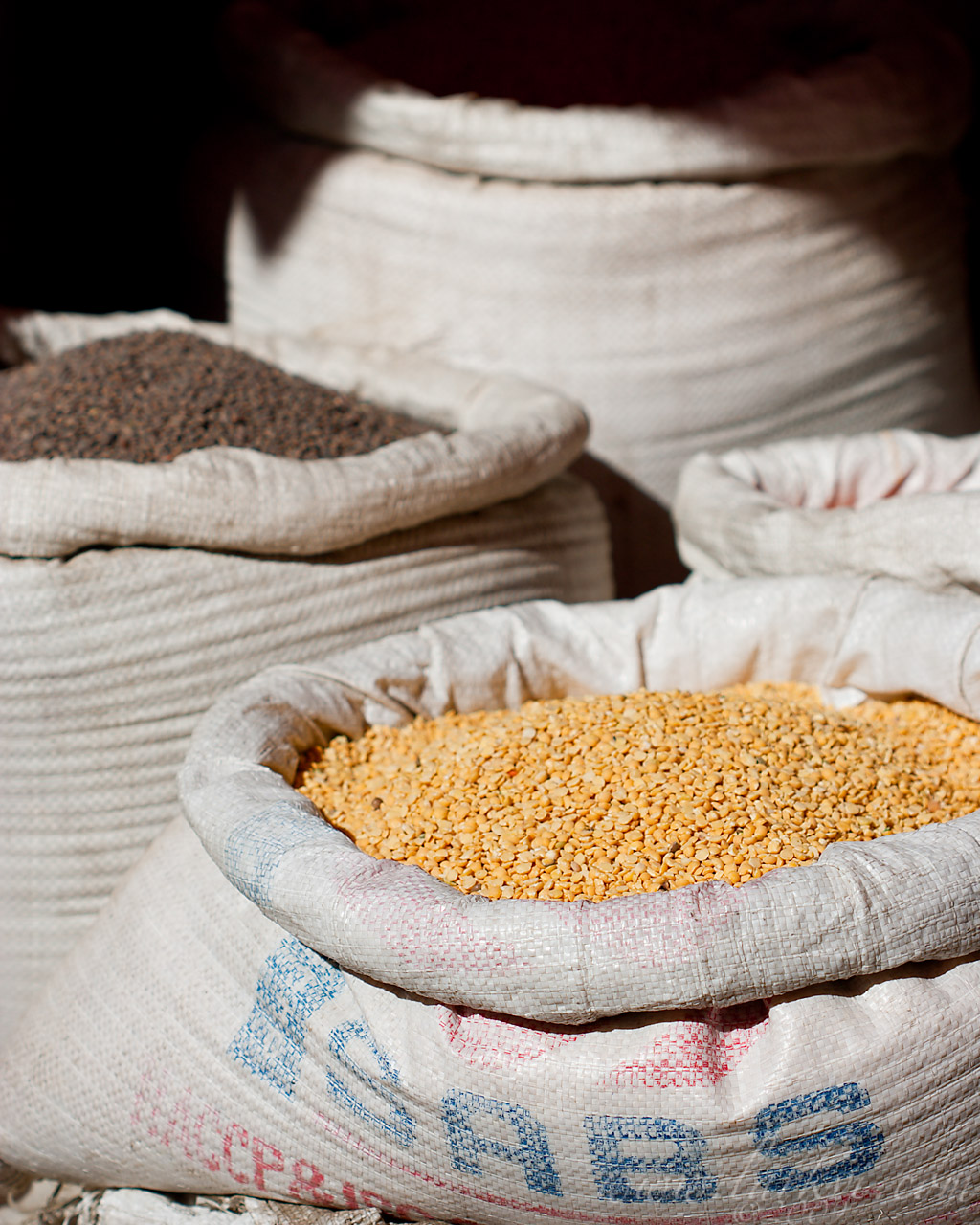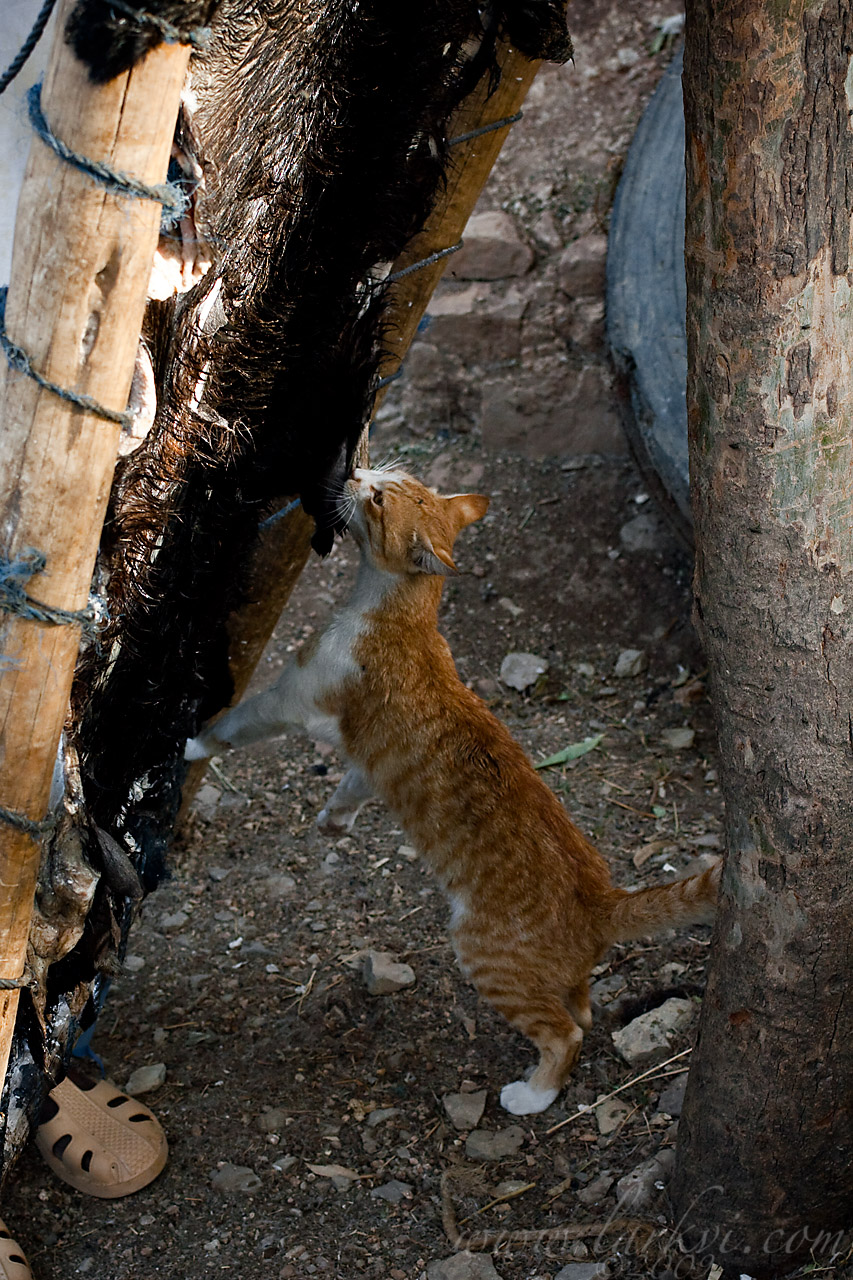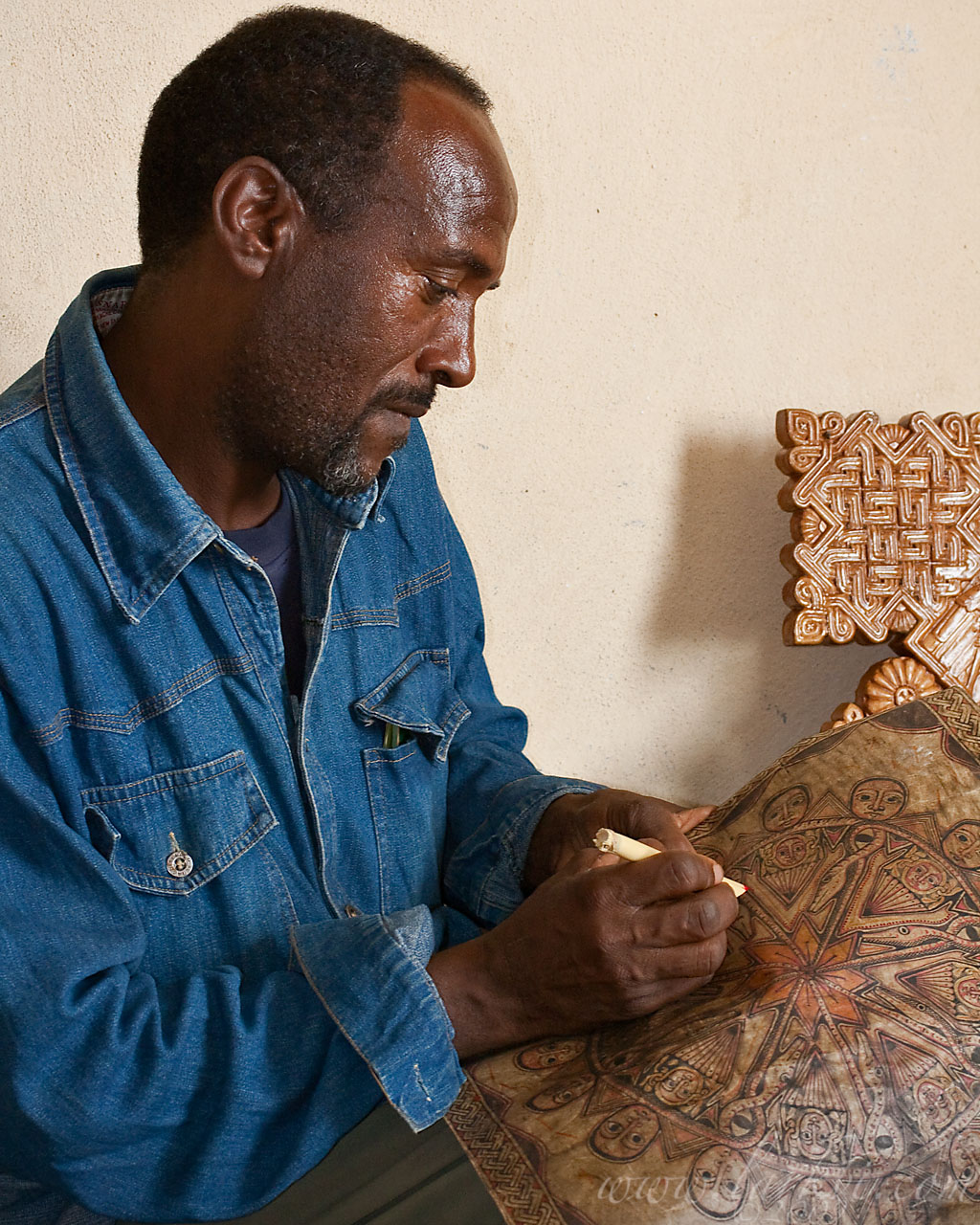Bags from various places hold legumes on display in the old market area of Mek’ele, capital of Tigray. Legumes are greatly consumed during the fasting season, and an important part of the diet year-round, as people fast on vegetables at least twice a week in the Christian parts of the country.
Cats Hate Fasting Season, Mek’ele, Tigray, Ethiopia, April 2009
Marigeta Birhanu’s cat was loudly letting himself be heard throughout our interview, and practically attacking the skin for parchment while stretched on the frame, before the meat was removed. It only occurred to me part-way through that the cat was subject to fasting season, just as the people are, because he eats leftovers from the table. Injeera may be sustaining for a cat, but rancid goat-meat was more to his preference.
Palm-Frond Ring, Adigrat, Tigray, Ethiopia, April 2009
Binding, Marigeta Birhanu, Mek’ele, Tigray, Ethiopia, April 2009
Ethiopian Manuscript Heritage Problems and Preservation Strategies
I recently lectured to both the first- and second-year classes of Heritage Preservation and Paleoenvironment students at Mekele University on the problems facing manuscript (and more general) conservation and preservation in Ethiopia. While not a full workshop (which I hope to conduct in November, if I can find funding to get back to Ethiopia), it was nevertheless an introduction to my work, the field, and the preservation/conservation challenges facing those tasked with preserving the knowledge and physical objects associated with the Ethiopian manuscript tradition.
While I have not the time to reprise the whole presentation, I will link here to the powerpoint portion, which outlines the talk, even as it only represents a small amount of what I said (I loathe talks where the presenter reads out his own slides, and will not do it myself). If this is of interest, I can go on at greater length, and if anyone finds this kind of material absolutely essential to their program, I am available to give this talk anywhere you care to pay my travel expenses to. . .
Friday Link: iTunesU
I have been traveling a lot in recent years, and my iPod and laptop have become my most constant and consistent companions. Accordingly, I turn to them a great deal for entertainment, but rather than playing games or listening always to music, I follow a great number of podcasts, from the purely educational to short-fiction pieces. Here in Ethiopia, I have no chances to take courses, so I have really come to appreciate iTunesU, a joint project of Apple and a variety of universities, comprising lecture series and even full courses. This is a great way to kill time on extended journeys and allows one to be aware of some of the scholarly work being presented at institutions far way.
Though there are several impressive universities participating, including MIT, the Open University, and Texas A&M, I have so far only had a chance to listen to the Humanities offerings of Stanford and Yale. Stanford, from what I have sampled, is doing a much better job of presenting interesting material, selecting from their excellent lecture series (which I have fond memories of attending while an undergraduate at UC Santa Cruz), whereas Yale Humanities seems, for the most part, to be producing pieces with advertising and alumni relations in mind, which I do not find very interesting. I have even been listening to two whole courses, an intro to the humanities course on the Literature of Crisis and an excellent course on the Historical Jesus. When I again have access to a fast internet connection, I will look deeper into Stanford’s catalogue as well as expanding the number of universities sampled, but I both highly approve and recommend iTunesU for the independent learner and scholar alike.
I’m trying to get the Friends of the Library of the Pontifical Institute for Mediaeval Studies to start recording and podcasting its lecture series–get out there and work on your institution!
There are two things you should remember before taking off on a trip: 1) you need iTunes (the podcasts interface manages the content) 2) read the syllabus and bring the readings.
Bet Ammanuel Maako Panoramic (mockup), Negash, Tigray, Ethiopia, April 2009
This is my preliminary mockup of a 20-image panoramic of Bet Ammanuel Maako church and its environs, from my recent trip to Negash. I don’t have enough memory or processing power to work on the full version out here in the field, but click through to the flickr page and select “all sizes” to see a much larger image (which still only represents 10% of the full-size image).
It is not unusual to see Ethiopian churches built in highly-inaccessible places; in fact, it is considered quite appropriate. Accordingly, I walked from where I shot this over three ridges and through two valleys, to get to the hill of the church, only to find, upon my arrival, an easy road which diverged from the highway only 100M from where I had begun my laborious journey. At least the walk back was easy. . .
Fasting Meal, Bet Ammanuel Maako, Negash, Tigray, Ethiopia, April 2009
During the fasting season (which is two weeks longer than Lent in Ethiopia), monks and priests, in addition to abstaining from meat and animal products, do not eat until 9 o’clock (which we foreigners would call 3PM). I happened to be at the church just as services ended, and the priests invited me to share their fasting meal. Exhausted from the substantial hike I had taken from Negash, over three ridges and through two valleys,* I readily accepted.
What is pictured is a very typical rural meal, especially during fasting season. It consists of injera, the stable fermented pan-bread of Ethiopia, made of a grain called teff** with a ‘wot’ (stew) of shiro (chickpea paste). The drink is ‘tella,’ a small local beer made of sorghum and barley, fermented with a leaf called ‘gesho,’ which serves in place of hops.*** The injera is dipped in the shiro and eaten, with the stew serving mainly as a flavorant for the injera, which is most of the meal. More injera (and always more tella) is provided, and one is usually prevailed upon to eat much more than one wishes to. A simple and nutritious meal.
That said, I am getting rather tired of injera.
*There was, of course, an extremely moderate road to the monastery which left the main road very near to my starting place, but which I could not see when I ventured to walk to the church, which is on an imposing height, standing out from the neighboring valleys.
**Almost unique to Ethiopia, teff is a cereal grain very high in both protein and iron. The tiny seeds are easily beaten off the stalk by rain, which contributes somewhat to Ethiopia’s prone-ness to famine (a larger factor is the gross overpopulation of the country, which has grown over 120% since 1960.)
***But is nowhere near as good. One foreigner describes tella as ‘looking like muddy lake-water and tasting much the same.’ That said, this tella was significantly better, though rather full of detritus.
Keshi Mengistu Eyesus, Mek’ele, Tigray, April 2009
Keshi Mengistu Eyesu is a woodworker, scribe, and painter working in Mek’ele. He is a consummate artist, and, though he focuses on woodworking (more profitable) now, his scribal works are excellent. Though he produces them with an ink wash, to "antique" them, they need no selling as antiques, as they are excellent modern examples of traditional Ethiopian art (I’m thinking of buying one myself). Here you can see him finishing off a healing scroll with red detailing, while a carved wooden processional cross of his production sits in the background.
Magic scrolls exist in a continuum with church scrolls in Ethiopian Christianity. As in many societies with low literacy rates, writing is associated with the ability to perform magic. In a Christian society like Ethiopia, this is doubly so, as people are familiar with the magical/miraculous abilities granted to the priesthood through the recitation of written documents of the Church. The learned liturgical specialists of the Church, däbtäras, are also suspected as magicians–the word for magician is däbtära–because they have access to knowledge which is secret, both because it requires literacy, and because it is actually secret. Church scrolls, containing prayers invoking the names of angels, Jesus, and the BVM transition into magic scrolls when, in order to grant additional power or a different kind of power, the secret names of devils, demons, and magical entities are used. Apparently, some of these names are written invisibly in a process that I was poorly able to understand, though I am working on it. In addition to scrolls, Ethiopians keep alive a tradition of amulets, both those familiar from Orthodox Judaism, containing biblical passages, and those of a less religious and more magical nature.
Mosque, Negash, Tigray, Ethiopia, April 2009
The mosque in Negash, by tradition burial site of several followers of Mohammed of the 116 (including his daughter and two of his wives-to-be) who, during his lifetime, fled to the Ethiopian kingdom to escape persecution in Mecca. They were received and sheltered by Negus Asihima** of Ethiopia, who was friendly with Mohammed during his lifetime. This hospitality is the basis for the Hadith*** exempting Ethiopia from Djihad,**** ‘so long as [the Ethiopians] leave [Moslems] alone.’ The mosque is also known as the ‘Tomb of Seid Ahmed al Negash,’ after the king, who allegedly converted to Islam and was buried there.***** Ethiopian Moslems consider Negash the most important site of worship after Mecca, though it seems to be little-regarded by those outside the country. The current mosque may be a medieval construction, built on the site of a 7th-century original, but the head of the local Heritage Preservation department has expressed doubts regarding the authenticity of the 7th-century construction, since it is unlikely that Christian Ethiopia would allow a mosque to be built over their (Christian) king’s grave and in light of the miniscule presence of Moslems in the area.
This photo has been corrected for perspective distortion.
* Ethiopian word for king. The name of the village, Negash, is from the Arabic form, Nejashi.
** Accounts of the name vary.
*** A report of a saying of the Prophet, the second level of Islamic tradition informing law, after the Qu’ran.
**** Djihad is the only form of warfare permissible under Islamic law; when the conditions are met, there is a religious obligation to carry out that war. Ethiopia, though part of the ‘Land of War’ (non-Moslem lands which are obliged to be converted, preferably by peaceful means, but, failing that, by conquest–as opposed to the ‘Land of Islam,’ where Islamic governments and established Islamic religion hold sway) is an (intermittent) exception.
***** The king was a Christian monarch and likely buried in Wukro, 10km away. Only later Moslem accounts claim that the Negus converted to Islam and was deposed for it. While certainly false, such reports have formed the basis for declaration of Djihad against the Ethiopians, since religious persecution (of Moslems–others do not count) is always cause for the waging of Djihad. Acts of past (Ethiopian Orthodox) and current (allied with the same) governments could similarly be seen as persecution by those looking for a justification for war, as Somalia’s Islamic Courts Union found (incidentally, the U. S. Dept. of State agrees–regarding persecution, not the war).








